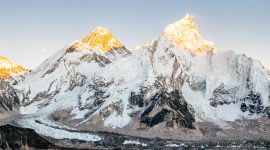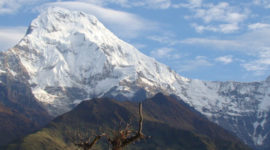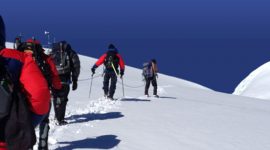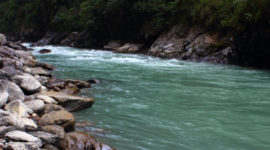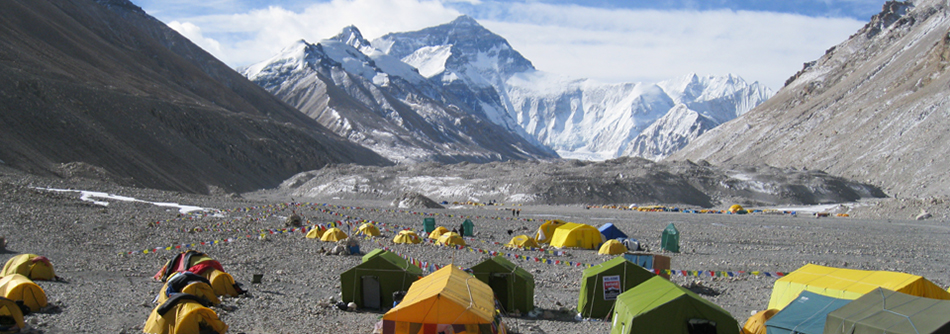In our unending efforts to create a hassle free and cost effective trekking and climbing experience for you in the Nepal Himalayas, we offer the free use of quality gear.
Gear we can provide to help you on all trekking and climbing trips in Nepal
- Good quality down sleeping bag, down jacket, fleece liner and rain poncho
- Snow gaiters on high altitude trekking and peak climbing trips as required
Camping while trekking and at base camp during peak climbing trip
- Mountain Hardware – 2 man sleeping tent
- EXPED down filled mattress for extra comfort
- Dinner tent with table and chairs with backrest
- Kitchen and staff tent
- Toilet tent with commode
Complementary Gear
- Trip duffle bag in which to keep all trekking and climbing gear
- MMA T shirts
- 4 season sleeping bag and liner
- Down jacket
Climbing Expeditions in the Himalayas –
We provide ALL gear – We provide all personal and group climbing gear so there is no need to buy expensive gear for just one trip.
- La- sportiva climbing boots,
- Black Diamond crampons, ice axe, ice bar, ice screw, zoomer, ice axe, harness, figure of eight, safety helmet, plain & locking carabiners, prussic cord and climbing rope etc.
Suggested checklist of personal gear for trekking and climbing in Nepal
Essential gear :
A pair of substantial trainers, a pair of lightweight pants and long shirts for day time, one pair short pants for trekking, a pair of warm trousers, rainproof jacket with hood, gloves, woollen socks, underwear, 2 water bottles – (each: one litre), day pack – ( around 35 litres), toiletries, towel, small torch or headlamp with spare batteries, sun block and sunscreen, personal medical supplies if any, camera and films/photo cards.
Seasonal gear :
In addition to the essential gear – you need to bring other gear relevant to the altitude of your chosen trek as follows:
- All trips below 3000 metres : Lightweight walking boots, woollen jumpers or polar fleece, thermal underwear ( while on winter treks only), cotton or technical T shirts, sunhat, sunglasses (100%UV filtering)
- All trip above 3000 metres – all season : Medium weight walking boots, 2 woollen jumpers or polar fleece, thermal underwear, woollen/ fleece warm pants, windproof/waterproof over pants, scarf/ Buff, cotton or technical T-shirts, sunhat and sunglasses (100%UV filtering)
- Optional Gear : Small padlocks, money belt, penknife or multi-tool, binoculars, energy bars, personal diary, playing cards and books etc.
Guidelines for choosing trekking/climbing gear
Walking Boots : Suitable boots made of leather or leather/cordura and Goretex lined if wished to keep feet dry depending on the length and difficulty of your trek – boots should have good ankle support and a durable sole preferably Vibram for a better grip in muddy or icy/snowy conditions. Boots should be generous fitting with ample room for toes – please note that thicker weight socks are also worn in the cold and that feet can swell a little when you have been trekking in the heat and also when trekking at altitude in Nepal Himalaya.
Rainjacket with Hood : Should come down well over the hips and have a proper adjustable storm hood. A jacket with Goretex lining is most preferable however an alternate waterproof jacket with a breathable membrane such as Hydronaute, Repel would be OK.
Woollen jumper or polar fleece : This is very useful when trekking in a slightly cool climate and in the evening. A microfleece top or lightweight wool jumper is very useful and can be worn under your jacket or raincoat comfortably.
Lightweight pants : Should be loose fitting and quick drying if possible – for instance technical polyamide or microfibre. Note that cotton often takes a long time to dry in the mountains. Jeans are definitely not suitable for trekking.
Warm trousers : For camp wear and on cold days for trekking. Thick fleece (200 or 300wt) or wool is recommended or fleecy tracksuit pants however these are not effective when wet.
Water bottles : At least 1 litre – however we strongly recommend two x 1 litre bottles as the minimum to ensure maximum hydration. They should be of good quality to withstand being filled daily with boiling water and will always remain watertight. You can. of course use sterilising tablets – please ensure you have a good supply.
Daypack: Of minimum 35 litre capacity with a comfortable harness and straps so that the majority of the weight rests on your hips rather than your shoulders. A more durable fabric will be more waterproof and the addition of a waterproof cover would be ideal.

